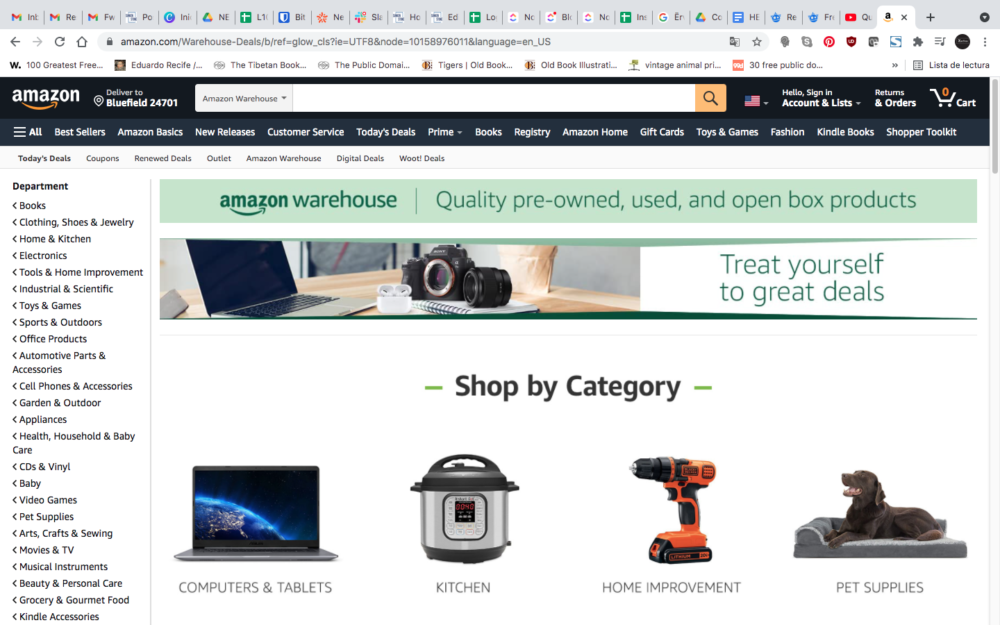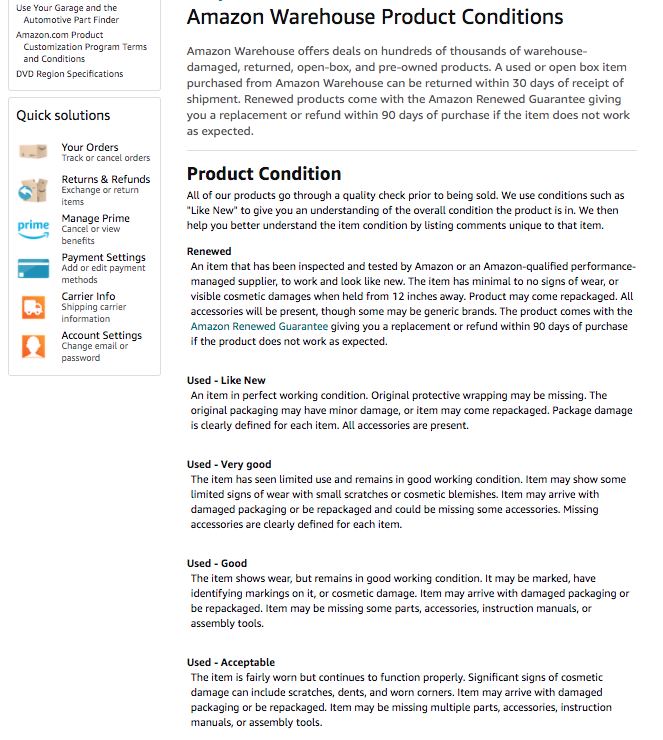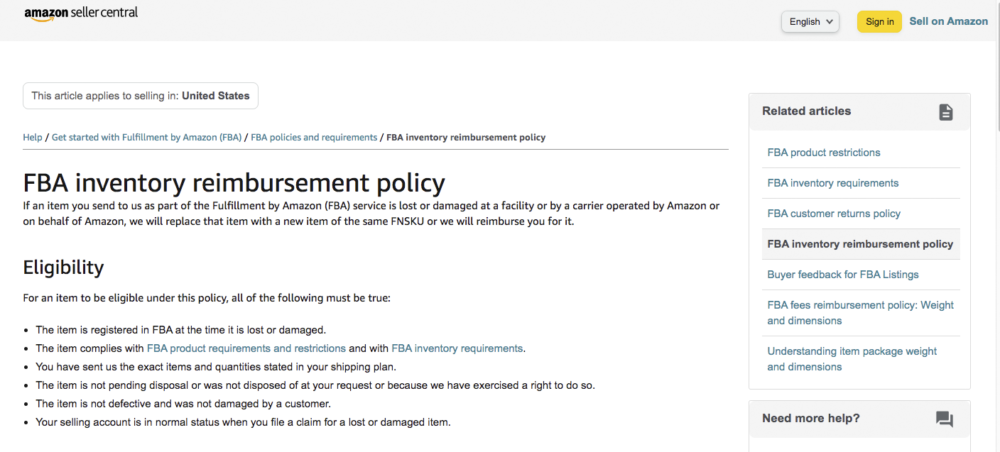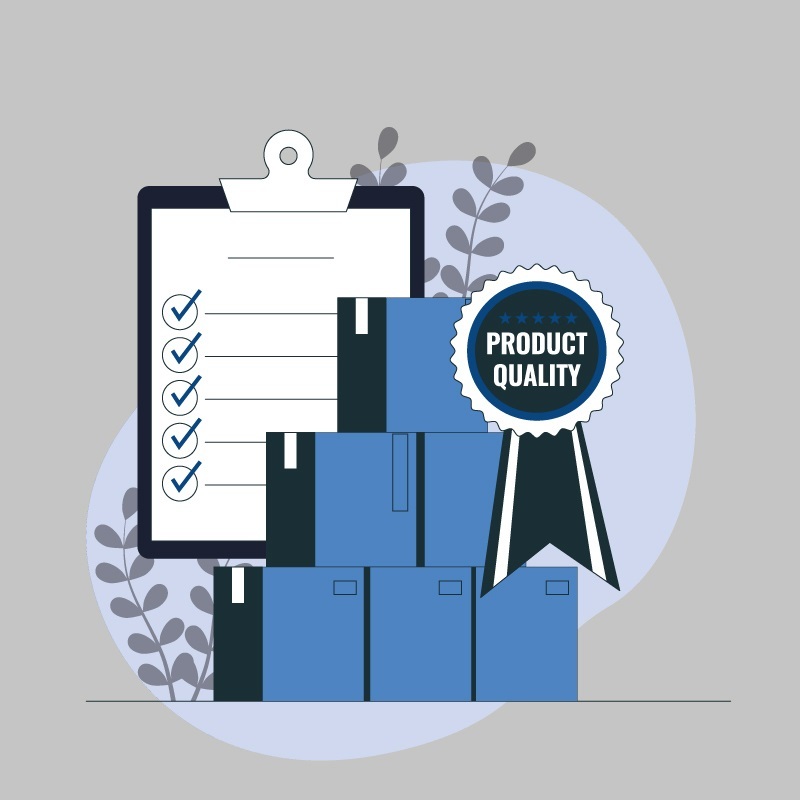
Amazon Warehouse Deals is a service Amazon offers on products that a customer returns or damages. Sometimes, Amazon also turns refurbished products into Warehouse Deals.
Before allowing a product to become a Warehouse Deal, Amazon completes a 20-point quality process and categorizes items by package quality.
Here’s what sellers and buyers should know about the Amazon Warehouse Deal program.
About Warehouse Deals in detail
Amazon’s Warehouse Deals program sells damaged, returned, or refurbished products from sellers in the Amazon FBA program at a significant discount. Products that sellers have in the Amazon Prime program can also become Warehouse Deals.

The Warehouse Deals is one of the most popular pages on Amazon.com.
All products that Amazon receives back from customers do not return to the seller’s inventory. Instead, returns in decent condition that pass Amazon’s quality checks become Warehouse Deals. Through these deals, Amazon provides an excellent opportunity for consumers to buy quality products at relatively low prices.
In this article, the point we’re making is whether sellers get anything out of these promotions and what opportunities lie for Amazon sellers.
How does Amazon Warehouse Deals work for consumers

Consumers can buy Warehouse Deals at discounted prices. As the above shows, there are five quality categories for items in this program, which depend on product conditions which can be summarized as:
- Renewed
- Used – Like New
- Used – Very Good
- And, Used – Good
- Used – Acceptable
The conditions of all the products are at least good. If products fail to pass Amazon’s 20-point quality check, then Amazon throws the product away. However, if products pass the verification process, Amazon categorizes goods by package and product damage.

Amazon Warehouse Deals products available at lower-than-usual prices
To purchase the products at a discount, customers can directly search for the Amazon Warehouse Deals or look for the deals on the product’s pages.
Besides the above five conditions, Amazon also has “Open Box” options. It means that the customer bought the product, and Amazon received the same item back after the customer opened the box.
How does Amazon Warehouse Deals work for sellers?
Sellers working through the Amazon Seller Central are not allowed to sell through Amazon Warehouse Deals.
Amazon deals with warehouse products on its own by identifying those which got damaged, returned, or refurbished and placing them under the Amazon umbrella.
If customers return the products, and they pass the 20-point quality test process of Amazon, then Amazon keeps the item, and the company makes a refund to the buyer.
Sellers whose products become warehouse deals receive compensation under Amazon’s Lost & Damaged policy.

Amazon’s Lost & Damaged policy safeguards items that are lost or damaged when under Amazon control.
The company compensates only for the products damaged or lost due to a mistake by Amazon. When there’s a manufacturing error, Amazon does not offset the production costs. Under the Lost & Damaged policy, sellers receive compensation for returns in the following ways:
- When Amazon pays sellers the replacement value for lost or damaged products.
- By replacing the sellers’ products with a new product of the same FNSKU.
Amazon determines the replacement value in several ways, which include:
- History of the sales generated by seller.
- The average selling price of the product of FBA.
- History of the sales of particular ASIN.
If the required information is not available, sellers receive compensation based on the default replacement policy. To get this compensation, Amazon may demand the product’s purchasing receipt or invoices. Amazon requests this for items that cost less than $5,000.
If your company sells items over $5,000, then insurance will reimburse you for lost or damaged products.
Does Amazon Warehouse Deals benefit sellers?
You might wonder how you benefit from Amazon keeping your company’s products.
Sellers get an indirect benefit of these deals as they cannot directly sell through Amazon, such as:
- Instead of bearing all the delivery and shipment cost, Amazon bears this cost for sellers.
- Amazon reimburses customers directly and only charges sellers FBA storage fees and regular FBA seller fees.
- Sellers do not have to collect the products and send them back to the manufacturer for repackaging. This saves a lot of money as the good after the return is a second-hand product.
Imagine the hassle for the seller who has to pick the product from FBA centers, send it back to the packaging company, and resend it to FBA centers.
Thus, Amazon saves sellers from product returns by offering products at a discount and provides different reasons for customers to purchase specific products. Customers willing to accept a damaged package are eager to take the risk of receiving a quality product.
Amazon Warehouse Deal Seller Account has a 78% positive rating, which shows that the majority of the customers ended up with quality products.
3 best practices to follow with Amazon Warehouse Deals
Amazon Warehouse deals are a win-win situation for both the customers and sellers. The customers get the best price for the quality product by compromising on the packaging quality.
While the seller can sell brand products without hassle, there are few things they should know to avoid any pitfalls.
- Sellers should give high consideration to the packaging of their products. Products travel long distances and packaging protects these goods. Thus, if the packaging is not of high quality, there’s a chance for product damage during shipping. Packages in Amazon Warehouses can also experience damage.
- You need to ensure that you maintain a complete record of the product’s invoices and receipts. Amazon compensates sellers by the value of the product and its purchase price. Thus, make sure that one can maintain the record of these receipts and invoices.
- Sellers should always maintain the record for the products placed in FBA. Before they deliver the products, they should confirm the quality of the packaging and get approval to avoid any future claims. Here are additional Amazon fulfillment requirements to know.
Why you should focus on your brand first

Emplicit helps brands focus more on building a great brand rather than quick-sales tactics.
Customers should therefore be as cautious as sellers while making any purchase from Amazon Warehouse Deals.
The reason is that these products are not usually under the manufacturer’s warranty.
To avoid any product problems, follow these best practices:
- Always review the return policy. Amazon offers a 30-days return policy for the products purchased through Amazon Warehouse Deals.
- Look into the cost to return. For the prime members, Amazon offers free cost to return, which gives them the privilege to purchase without any worry.
- Look for accessories of the products and ensure that the vital accessories are available, otherwise, it is as useful as a damaged product.
- Consider other cost and fulfillment factors. These include the cost of delivery, shipment time, and similar factors, which sellers should evaluate.
Amazon Warehouse Deals are an excellent opportunity for customers to receive items at a discount.
However, sellers do not benefit much from these deals. They have no control over the products. Once the products become warehouse deals, Amazon owns those goods.
Focusing on your brand first is the best way to benefit from Warehouse Deals because, ultimately, you don’t want items to end up there, you want them to stay in the hands of people who purchase them, and that’s a measure of retention.
Your brand is vital in that equation, just like the quality of your products.

